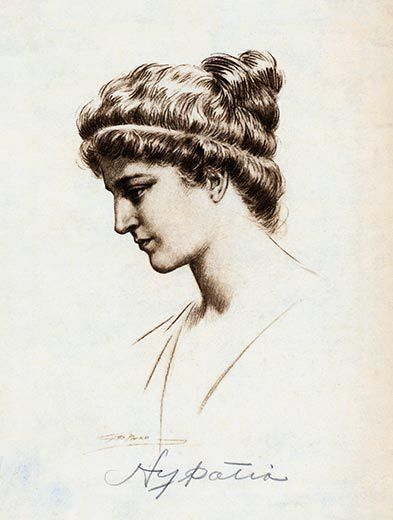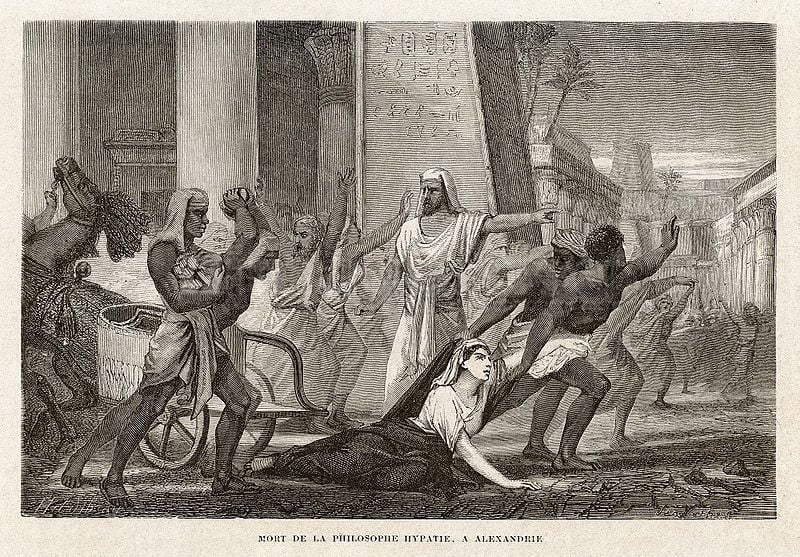Chapters
Hypatia of Alexandria was born around 350-370 CE. She was a Hellenic mathematician, astronomer, and philosopher; head of the Neoplatonic school in Alexandria, where she taught astronomy, philosophy and mathematics.
The history of the extremely brutal murder of Hypatia, who was killed by a crowd of Christian believers – possibly – on the initiative of the bishop of Alexandria, Cyril himself, who was recognized by the Church as a saint. However, there are still disputes on this topic as to whether Cyril was in fact involved in the death of Hypatia and what was dictated by the murder of the genius woman.
Activities
Hypatia was the only daughter of the mathematician Theon of Alexandria, with whom she probably created several of his works. However, no treaties have survived our times. However, scientists are still doing research on this topic. She was educated in Athens so that in about 400 CE become the head of the School of Neoplatonism in Alexandria, where she also passed on the knowledge of Aristotle and Plato. Both Christians, pagans and foreigners could attend the school, which proves her calm and liberal approach to faith and life.
Her activity was assessed differently by Christian circles. In the 7th century, for example, the Byzantine chronicler John of Nikiu identifies Hypatia as a Hellenic pagan who taught Satanic knowledge, magic, and witchcraft. Some Christians, however, appreciated her knowledge and described it as a symbol of virtue.
Circumstances of death
The most complete ancient source about Hypatia’s death is written in 415 CE the work of Socrates Scholastica – History of the Church (HistoriaEcclesiastica), which was based on present events. The work shows not only the moment of killing Hypatia but also the circumstances of the murder and riots in the city.
The mood in Alexandria escalated in 412 CE, when the nephew of Archbishop Theophilus, Cyril, became the bishop of Alexandria. The new bishop fell into a political conflict with the governor of Alexandria (praefectus augustalis) – Orestes – who was also a former student of Hypatia. Cyril reportedly was jealous of Hypatia’s popularity in society and her good relations with Orestes.
The author mentions that in 415 CE there were Jewish ceremonies in Alexandria that usually turned into civil unrest. Orestes, in order to put an end to such events, issued an edict regulating the congregations in the city. The document was put on public view in a local theatre, which also attracted huge crowds. The edict caused great indignation among both Christians and Jews. Cyril’s Christian follower, Hieracas, used this moment to call for the adoption of a new law and to encourage rebellion.
Orestes acted decisively and violently to have Hieracas captured and tortured in public in the theatre. The aforementioned Socrates states that he did so out of fear of the growing power of the bishop. Cyril, in turn, strongly criticized Orestes, threatening to escalate the conflict and take revenge on the Jews if other Christians suffered. This sparked an avalanche of aggression by Jews against Christians. Jews allegedly murdered the Christians they encountered all night.
On the next day, Cyril and his followers went to the city in search of the perpetrators of the massacre. The Jews were surrounded, robbed of their valuables, expelled from Alexandria, and their houses plundered. Orestes was shocked by the events and the fact of trying to drive a large part of the city’s inhabitants out. Both sought support from the emperor and a solution to the case.
Unexpectedly, following the news of the unrest in Alexandria, about 500 armed monks1, residing in the Nitria Mountains, came to the city to support Cyril in the conflict with Orestes. In the streets, monks surrounded Orestes’ cart and severely injured him. However, the inhabitants of Alexandria came to his aid, who then tortured the guilty of injuring the governor, a certain Ammonius, who died as a result of his injuries. Cyril, hearing about this event, ordered Ammonius to be considered a martyr, and the Christians themselves became angry.
Hypatia herself found herself in the midst of this conflict. It is worth mentioning that she was a respected citizen of the city and Orestes himself often used her suggestions and advice. In this case, she became the scapegoat. She was blamed for Orestes’ reluctance to cooperate with Cyril.
A crowd of Christians, led by one Peter, whom Socrates described as a fanatic, kidnapped Hypatia on her way home. Then she was dragged to the church Caesareum and stripped of her clothes. Socrates reports that her body was wounded and skinned alive with the help of ostracon, shells, and roof tiles. Crippled, she died and her body was burnt. The reasons for such an attack were the practice of witchcraft, Satanism and the godlessness of Hypatia.
The news of the events caused the crowds to become furious and turn against Cyril and the entire Church of Alexandria.
Another source of information about Hypatia’s death is the Chronicles of the world by the Byzantine writer John of Nikiû. The work was created in the 7th century and is extremely negative towards Hypatia herself and the governor of Orestes. The author claims, inter alia, that Orestes fell under the “demonic charm” of Hypatia and often resigned from visiting the Church, and also called for abandoning the profession of Christ.
Ultimately, the case of Hypatia’s murder was proverbially swept under the carpet, and no one was charged with the murder. After the woman’s death, Orestes lost his position as city prefect and left Alexandria. Cyril himself established his position, and after his death was declared a saint. Maria Dzielska emphasizes that Cyril, after the death of Hypatia, issued the anti-pagan treatise Contra Julianumin response to the published during the reign of Emperor Julian the Apostate Contra Galilaeos.
Summary
The death of Hypatia arouses the curiosity of scientists to this day. There is a reason why she is called “the martyr of science”. It is not uncommon for historians to consider her death as a turning point and the end of antiquity (Kathleen Wider). Stephen Greenblatt, in turn, believes that her death brought down science and light in Alexandria; However, Christian Wildberg is of the opposite opinion, who notes that the intellectual development of this city was still in the 6th century.
Many modern researchers believe that Hypatia was a genius of his time, familiar with many fields of science. Aleksander Krawczuk believes, inter alia, that Hypatia was very intelligent and liberal for her time, which was against the politics and philosophy of the church. Moreover, the woman was considered an ally of governor Orestes, which also did not work to her advantage in the situation of the authority-church conflict.
Scientists are not entirely sure what Cyril was involved in the entire murder on Hypatia; It is certain, however, that he did not even act to resolve the matter and, using his influence and power, he silenced the topic. Cyril is certainly morally guilty of Hypatia’s death, especially given the sermons he preached in which he accused a woman scientist of practising witchcraft.









